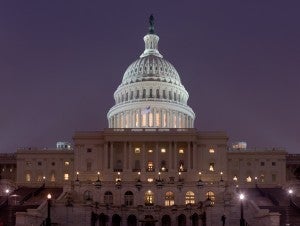It can be hard to interpret political maneuvering inside the Washington Beltway, and today’s Senate votes on the U.S. Clean Power Plan are no exception. So take it from someone who keeps a close eye on these votes in Congress — this was a good day for the Clean Power Plan, for U.S. climate leadership, and for a clean energy future.
Why?
Because today’s votes showed that the Clean Power Plan has gained support in the Senate since a test vote earlier this year.
More importantly, today’s votes demonstrated that the Senate is well short of what is needed if Senators truly want to stop the Clean Power Plan from taking effect.The measures that were passed narrowly today (52-to-46) are going nowhere. President Obama will veto these efforts to undo the Clean Power Plan, and there are more than enough supporters of the plan in Congress to sustain the veto.
The Clean Power Plan is a Clean Air Act initiative to cut dangerous carbon pollution from power plants and spur growth in clean energy. It is an important part of America’s leadership strategy on climate change, which is helping not only to accelerate the transition to clean energy here at home but also to inspire actions by other nations, including China. With world leaders set to convene global talks on climate change in the coming weeks, it’s important to put today’s votes in context.
For two years — even as the U.S. Environmental Protection Agency was developing the Clean Power Plan — Senate Leader Mitch McConnell of Kentucky has been promising to block the rules any way he could. In March, he launched a symbolic attack on the Clean Power Plan that passed the Senate 57-43.
In today’s vote, which was based on an infrequently used procedure called the Congressional Review Act, McConnell’s margin of victory grew smaller. Three Republicans (Senators Kelly Ayotte of New Hampshire, Susan Collins of Maine and Mark Kirk of Illinois) broke from McConnell and supported the Clean Power Plan.
Since the rule’s release this summer, public support for limits on carbon pollution have only increased. According to a Public Policy poll done this month, 60 percent of voters in Iowa support the Clean Power Plan, while 70 percent of voters in Illinois and 64 percent in Virginia support it.
The Clean Power Plan comes at a time when shifts in technology are opening new pathways to clean energy. Even utility companies recognize that a fundamental shift has taken place. The CEO of one of America’s largest coal burning power companies, AEP, recently said he views the Clean Power Plan as a:
catalyst for the transformation that’s already occurring in our industry
The Clean Power Plan is also just one element of a bigger turning point in American policy on clean energy and climate in recent years. The adoption, a few years ago, of dramatically increased gas mileage standards and greenhouse gas limits for cars is no longer a matter of controversy. States like California and a consortium of nine northeastern states are demonstrating that market-based climate pollution limits are good for economic growth.
The bottom line is that today’s votes to “overturn” the Clean Power Plan were all about political theater. Everyone involved knows the congressional resolutions will ultimately fail, so it’s a free vote for politicians who want to appeal to a relatively narrow slice of the electorate.
The larger narrative, which is the transformation of the United States into a global leader to protect the next generation from climate pollution, is the real story.










